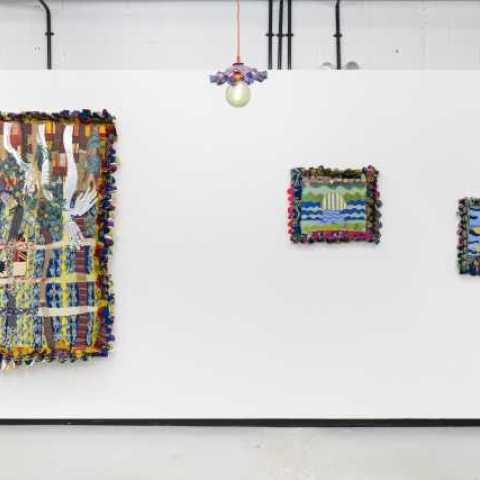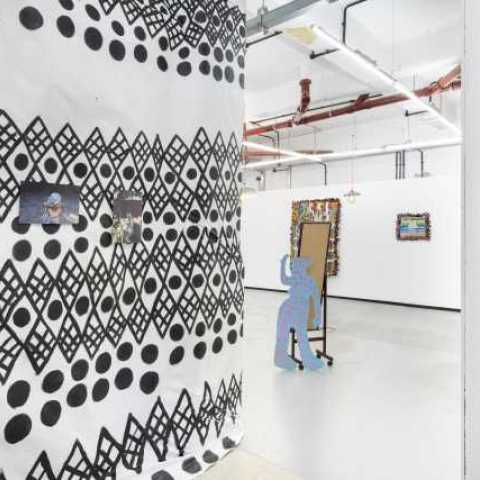Kupfer
Kupfer
Unit 5, 31a Chatham Place
London
E9 6FJ
United Kingdom



if mama
could see
she would see
lucy sprawling
limbs of lucy
decorating the
backs of chairs
lucy hair
holding the mirrors up
that reflect odd
aspects of lucy.
Lucille Clifton¹
For its next solo show, Kupfer is turning into a living room. Complete
with chairs, curtains, lampshade, mirror, flower vase and table, Abi
Ola invites us into her private world of patterns and portraits.
Through a compulsive use of emojis, traditional West African fabrics,
photography and British floral designs, Abi Ola’s works are a
collection of personal chapters on identity, self-preservation,
familial connections and pictographic forms of communication. Her
paintings, textiles and sculptures rely on the relationship between
shape and colour, from which she creates complex rhythmic structures
drawing on simple, systematically repeated patterns. However, in her
case, repetition does not function as a study or a tool used for
emphasis or depuration purposes, but as a form of distortion or
distraction.
Having to navigate the world from a place of neurodiversity, Abi’s
practice reflects her need and desire to welcome people into her
private sphere whilst also protecting herself. Her most recent works
resort to the repeated use of mirrors and metallic materials. Mirrors
are both reflecting and distracting; we look at them as an attempt to
decipher the many ways our selves are shaped by internal and external
forces, revealing the unavoidable juxtaposition between our self-image
and the gaze of others. Her work invites the viewer to engage with her
choice of reflective materials as if by saying, in no particular
order: don’t look at me, look at you, or don’t look at you, look at
me. We see the mirror, and the mirror sees us.
In her photographic self-portraits and moving image works, Abi often
appears eating in patterns – sometimes bananas, sometimes
marshmallows. The photos are taken by the artist’s sister in her
garden, bedroom or living room. “Taking photographs at home is also a
way for me to invite the viewer into my world and private space, while
also keeping them at a distance using the filter of the camera”, she
says. There are many different ways in which Abi’s family is brought
into the work. She often uses photos of her aunt and female family
friends as references for her paintings. In Bouquet 1 and Bouquet 2
(2022), the floral designs are inspired by dresses worn by her mother.
Different patterns represent different family members and their
personalities. Finding patterns or archetypes within the family
becomes another means of examining the constantly reflective aspect of
our understanding of the self.
Abi’s figures are mostly faceless, sometimes they even appear to be
headless, such as in A Window to My Reflection 1 (2022) and A Window
to My Reflection 2 (2022). “I want the viewer to see themselves in
them”, she explains. However, despite the surfacing of many faceless
textile figures in her works, there is no shortage of faces in Abi’s
practice: screen-printed emojis invariably populate her signature
patterns. Emojis are translated emotions. They contribute to the
semantic content of our digital messages by helping us communicate in
a simple, easily conveyable way. However, the outsourcing of our
emotions to tiny yellow faces can also be a form of deflection; emojis
are echo-makers, often trapping us in repetition and distortion, or
likes and unlikes, such as in her poignant I’ll Be Your Mirror (2023).
Good mirrors are not cheap, says Audre Lorde, it is a waste of time
hating a mirror or its reflection². By lining the gallery with canvas
and turning her world of patterns back onto us, the artist invites us
to face up to our own image in her portraits and living room. Whilst
the echo of emojis cannot but distract the message, the mirror
distorts the image – hers, her subjects’ and ours. Abi Ola could be
hiding behind her mirrors but she is also reflecting outwards.
¹ Lucille Clifton, “if mama / could see” from Good Woman: Poems and a
Memoir, 1969-1980, 1987
² Audre Lorde, “Good Mirrors are Not Cheap” (1970) from The Collected
Poems of Audre Lorde, 2000
Abi Ola (b. 1996, London) is an artist living and working in London.
She graduated with an MFA from the Slade School of Fine Art (2021),
and has a BFA from Goldsmiths (2019). She was recently granted the New
Contemporaries Award 2022. Her solo shows include Kaleidoscopic Bodies
(2022) at Frans Kasl Projects, in Eindhoven, Netherlands, and All Are
Gone The Old Familiar Faces (2022) at Flatland Projects,
Bexhill-on-Sea, UK. She had a group exhibition at Rawlinson & Hunter
alongside the Ingram Prize alumni, and a group show at Christie’s,
London, as part of the Good Eye Projects Residency, both in 2022.
Curated by Penelope Kupfer
